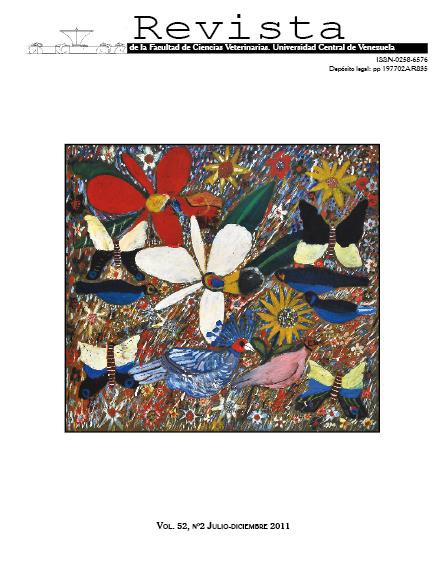Evaluación de la Prolificidad Acumulada de la Cerda y Peso Acumulado de Camadas al Nacimiento en Los Grupos Raciales Large White, Landrace y Cruzados
Contenido principal del artículo
Resumen
Con el objetivo de evaluar la vida productiva de cerdas de las razas Large White (LW), Landrace (LR) y sus cruces recíprocos, se analizaron 2444 registros de prolificidad (TAN) y peso acumulado de la camada al nacer (PAN). Los registros de las cerdas provinieron de una granja comercial ubicada en el estado Yaracuy. Los datos fueron ajustados por mes, período de años y número de parto. Para el análisis final se agruparon los años de nacimiento de las cerdas en dos períodos: 1986 – 1998 y 1999 – 2005. Se consideraron las cerdas con la oportunidad de tener al menos tres partos. Se realizaron análisis de varianza por el procedimiento de máxima verosimilitud restringida. Los efectos incluidos en el análisis fueron: grupo racial de cerda (GRC: 1,…,4), período de nacimiento de la cerda (PN: 1, 2), mes de nacimiento de la cerda (MN: 1,…, 12), GRC*MN y la edad al primer parto como covariable. Se obtuvieron promedios ajustados y no ajustados de 39,27 y 39,3 lechones; y 59,5 kg y 59,58 kg para TAN y PAN, respectivamente. Las cerdas del grupo racial LR*LW (42,69 lechones y 63,32 kg) y LW (41,44 lechones y 62,57 kg) resultaron superiores (P<0,01) en TAN y PAN, respectivamente. Hubo efecto estadístico significativo de PN, MN y GRC*MN. La heterosis fue significativa para (TAN) con un valor de 5,9%. Se concluye que las cerdas puras o cruzadas cuyo genotipo posee alelos provenientes de madres de la raza LW, son superiores para los caracteres evaluados.
Abstract
With the purpose of evaluating the productive life of Large White (LW) and Landrace (LR) sows and their reciprocal crosses, 2.444 records of prolificacy (TAN) and aggregated weight of the litter at birth (PAN) were analyzed. The sow records came from a commercial farm located in the State of Yaracuy, Venezuela. The data were adjusted by month, period of year, and farrowing number. For the final analysis, the years of birth of the sows were grouped into two periods: 1986-1998 and 1999-2005. Sows with a chance of at least delivering three farrowings were considered. An analysis of variance (ANOVA) by the restricted maximum likelihood procedure was performed. The effects included in the analysis were: breed group of the sow (GRC: 1… 4), birth period of the sow (PN: 1, 2), month of birth of the sow (MN: 1 …12), the GRC*MN interaction, and the age at first farrowing as covariate. The adjusted and non-adjusted TAN averages obtained were 39.27 and 39.3, respectively; and the adjusted and non-adjusted PAN averages were 59.5 and 59.58 kg, in that order. The sows of LR*LW (42.69 piglets and 63.32 kg) and LW (41.44 piglets and 62.57 kg) breed group were higher (P<0.01) in TAN and PAN, respectively. There was a statistically significant effect of PN, PM, and GRC*MN. Heterosis was significant for TAN, with a value of 5.9%. It is concluded that purebred sows and their crosses whose genotype have alleles from mothers of the LW breed, are superior for the characteristics assessed in this research.
